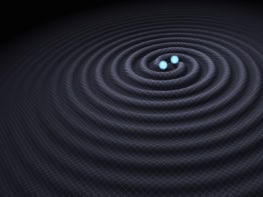The devastating collapse of the iconic Arecibo Observatory last month has left a large hole not just in astronomy but with the people of Puerto Rico too, as Liz Kruesi reports

On 1 December 2020 disaster struck on the island of Puerto Rico. A few minutes before 8 a.m. local time the iconic Arecibo Observatory collapsed, devastating the radio-astronomy community and planetary-radar scientists. The radio telescope’s suspended platform – with its Gregorian dome focus and a plethora of instrumentation – fell after multiple suspension cables failed. The 900-tonne platform crashed into the 305 m dish lying 137 m below. It was the ending that many had feared would meet the legendary telescope, leaving a community of researchers, staff and the people of Puerto Rico in mourning.
Astronomers hold their telescopes in high regard and Arecibo was instrumental in understanding compact objects like pulsars and other remnants of once-massive stars. It was a crucial tool in studying the surfaces of solar system objects and especially for learning about potentially hazardous objects to Earth. And it was an icon in the search for extraterrestrial intelligence, known as SETI. The collapse now leaves a gaping hole in astronomy and atmospheric geoscience.
Arecibo was an engineering and architectural marvel. The dish itself, made of nearly 40,000 perforated aluminium panels, each about 2 m by 1 m, sat in a natural sinkhole in the Puerto Rican jungle. Suspended like a bridge 137 m above a canopy of trees was a platform where antennas, reflectors, receivers, platform motors and other instrumentation sat. The telescope first came online in 1963 and an upgrade in 1974 added a radar transmitter.
In the 1990s the telescope and its instrumentation were further upgraded – including the addition of the three-storey-tall Gregorian dome. In that upgrade, 12 new auxiliary cables were added to the six main ones strung between three reinforced concrete towers situated around the dish to help support the additional weight. “It is a magical place,” recalls astrophysicist Laura Spitler from the Max-Planck Institute for Radioastronomy in Bonn, Germany. “It’s greener than you can imagine. In the evening you get hit by the humidity and the sound of all the frogs chirping.”
Yet over the past 15 years, Arecibo suffered from budget reductions and in 2017 a category-4 storm – Hurricane Maria – slammed into Puerto Rico, damaging and flooding the site. In early 2018, with the observatory at risk of closing, a new collaboration – the University of Central Florida; Metropolitan University in San Juan, Puerto Rico; and Yang Enterprises in Oviedo, Florida – stepped in to manage the observatory and increase funding. But it was not enough. On 10 August 2020 an auxiliary cable slipped out of its socket on “tower 4” and swung down, carving a 30 m gash into the dish below. Once the auxiliary cable failed, the other cables had to take on more tension.
The management team brought in multiple consulting engineering firms to assess the structure and the tension on those cables, and they found that the remaining cables should hold it in place. But on 6 November, one of the four main cables attached to tower 4 snapped when it was carrying some 60% of its designed load. The environmental factors of the site over the years – from constant moisture, storms and earthquakes – had degraded the cables faster than expected. Some reports also suggest that poor maintenance may have accelerated the wear on the facility. The same independent engineering firms re-evaluated the site after the second cable failed and came to a different conclusion.
Speaking at a press conference two weeks later, Ralph Gaume, director of the division of astronomical science at the National Science Foundation (NSF), said that engineers had advised them that “the loss of one more cable on tower 4 will likely result in a catastrophic uncontrolled collapse”. Gaume and colleagues announced at that point that Arecibo would be decommissioned and safely dismantled – fixing it was no longer an option given the structural integrity and safety considerations for workers onsite.
To track any new wire breaks – each main cable was made up of about 170 wires – Arecibo staff used cameras in the main operations room and drones to monitor the situation every few hours. Further wire breaks were spotted on cables at tower 4, then on 1 December at about 7:55 a.m. local time, one of the main cables snapped, with others quickly following. The platform swung and pulled cables out of the other towers. And then the 900-tonne platform came crashing down onto the 305 m dish. Arecibo Observatory staff who live onsite heard the collapse and news spread quickly through social media. “It was just such a shock when it actually happened. I think many of us are still really taking it in,” says Robert Minchin, a radio astronomer from Universities Space Research Association, who between 2005 and 2018 was a staff astronomer at Arecibo.
A legend falls
Arecibo was a multifaceted research instrument. Its size made it the most sensitive radio telescope in the world for decades, peering into space to collect faint signals. Its observations led to the 1993 Nobel Prize for Physics being awarded to Russell Hulse and Joseph Taylor Jr for the discovery of a new type of pulsar that led to new ways to study gravity. The dish was the largest single-dish telescope in the world until 2016 when China’s Five-hundred-meter Aperture Spherical Radio Telescope (FAST) came online. One of Arecibo’s most important contributions was its series of sky surveys of compact stellar objects, mysterious pulsing radio signals and the diffuse gas between galaxies.
Arecibo’s SETI work was also iconic. Scientists would look through Arecibo data for narrow-band radio signals, such as a navigation beacon, accidental radar, television broadcasts or some other form of radio leakage from another civilization. Dan Werthimer, a researcher at the University of California, Berkeley’s SETI Research Center, and colleagues developed a “piggyback” technique at Arecibo. “We figured out a way to use the telescope at the same time that other astronomers were using it to do their sky surveys,” he says. “We would just go along for a ride.” Werthimer was also one of the developers of the SETI@home project, which launched in 1999 and used processing power on personal computers around the world while the machines were asleep to analyse data from Arecibo’s SETI search. After more than 20 years, in March 2020 the volunteer aspect of the initiative “went into hibernation”. Dramatic footage emerges of Arecibo Observatory collapse
In 1974 Frank Drake and the late Carl Sagan used the just-installed Arecibo transmitter to send a message toward globular cluster M13, which hosts thousands of stars. Encoded in that beamed “Arecibo Message” – a message to another intelligent civilization, if they intercepted it – were graphics of DNA, a sampling of biochemicals of Earth-based life, the solar system, a stick-figure human, and a drawing of the telescope. Lasting just under three minutes, the pictorial message contained 1679 bits, arranged into 73 lines of 23 characters.
That transmitter, used for the Arecibo Message, was also what enabled planetary radar work at Arecibo. It would send radio waves toward planetary objects, such as just-discovered near-Earth objects, planetary moons and asteroids. “The signals scatter from the surface of those objects, and then we detect the echo,” explains Anne Virkki, who has led the planetary radar group at Arecibo. They compare the transmitted and received signals to learn about the object’s distance, motion, size and surface. A large portion of this work involves characterizing potentially hazardous-to-Earth objects, and Arecibo took on much of this planetary defence work. The next-best facility is some 20 times less sensitive. It is also part of the Deep Space Network, with a priority of communicating with spacecraft. The planetary defence work at Arecibo, funded by NASA, is part of this idea that the telescope could continue to evolve. “Arecibo was a telescope that kept reinventing itself,” says Werthimer. “It wasn’t the telescope that was born in the 1960s; it kept getting better and better.”
The NSF says it is not closing Arecibo, which also houses an education centre, a 12 m radio telescope and a LIDAR facility
Arecibo was doing science right up until 10 August 2020, when that auxiliary cable failed. Minchin and his colleagues had collected sky survey data the day before. Spitler, who studies transient radio sources including millisecond-long flashes of radio waves called fast radio bursts, had been monitoring one as recently as 8 August.
The National Science Foundation (NSF) says it is not closing Arecibo, which also houses an education centre, a 12 m radio telescope and a LIDAR facility. But questions remain whether the observatory can still have the same draw without the 305 m telescope. There have been calls to rebuild, producing a more advanced structure in the same location. But it’s not a simple task. “The NSF has a very well-defined process for funding and constructing large-scale infrastructure including telescopes,” says Gaume. “It’s a multi-year process that involves congressional appropriations and the assessment and needs of the scientific community. So it’s very early for us to comment on the replacement.” A petition to rebuild the telescope has had more than 100,000 signatures.
Arecibo’s legacy – a symbol of inspiration
Arecibo was more than a metal dish in the jungle. it was a place that inspired generations of people to study the universe and our place within it. “We recognize the significance of this loss to Puerto Rico and the significance of this loss to so many who have called the observatory home,“ notes Ashley Zuaderer, Arecibo programme director at the National Science Foundation. Indeed, Arecibo’s legacy is the community it built and inspired. The scientists it helped forge, the people who turned to it to understand our place in the stars, and the local Puerto Ricans who it filled with pride.
On 19 November, after the National Science Foundation announced it would decommission Arecibo Observatory, planetary scientist Edgard G Rivera-Valentín from the Lunar and Planetary Institute in Houston, Texas, who grew up in Arecibo, Puerto Rico, started the hashtag #WhatAreciboMeansToMe on Twitter, which received hundreds of responses. “Arecibo is more than an icon in Puerto Rico. It is part of our culture,” Rivera-Valentín told Physics World. “Over the past 57 years, it has woven itself into the Puerto Rican culture and has become a symbol of science and excellence in Puerto Rico. A symbol of our hopes and dreams to improve, to grow and to achieve. A symbol of inspiration.”



